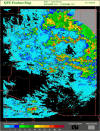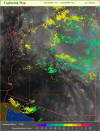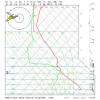|
BESIEGED BY EASTERLY DOWNSLOPE AGAIN
July 21 & 22, 2006
Yesterday, Friday July 21, 2006, was quite similar to
Saturday the 15th. Easterly winds mixed through the boundary layer and
southeast Arizona experienced another day of hot, dry, downslope winds.
The winds at the surface became easterly at the TUS observation site
around 10 am. Here at the house the winds were depressingly strong from
the east after about 1 pm. The TUS observations, below, show that
dewpoints plunged all the way into the upper 30s, a terrible state of
affairs.
|
21 Jul
7:55 pm |
102 |
41 |
13 |
ENE |
7 |
10.00 |
|
CLR |
1006.1 |
29.89 |
27.153 |
|
|
|
|
|
|
|
|
|
21 Jul
6:55 pm |
106 |
37 |
10 |
E |
9 |
10.00 |
|
CLR |
1005.5 |
29.87 |
27.135 |
|
|
|
|
|
|
|
|
|
21 Jul
5:55 pm |
107 |
39 |
10 |
NE |
12 |
10.00 |
|
CLR |
1005.2 |
29.86 |
27.125 |
|
|
|
|
|
|
|
|
|
21 Jul
4:55 pm |
108 |
39 |
10 |
ESE |
10 |
10.00 |
|
CLR |
1005.5 |
29.87 |
27.135 |
|
|
|
|
110 |
103 |
|
|
|
21 Jul
3:55 pm |
110 |
40 |
10 |
ESE |
13 |
10.00 |
|
CLR |
1005.7 |
29.88 |
27.144 |
|
|
|
|
|
|
|
|
|
21 Jul
2:55 pm |
108 |
40 |
10 |
NNE |
8 |
10.00 |
|
CLR |
1006.5 |
29.90 |
27.162 |
|
|
|
|
|
|
|
|
|
21 Jul
1:55 pm |
107 |
40 |
10 |
VRBL |
5 |
10.00 |
|
CLR |
1007.3 |
29.93 |
27.190 |
|
|
|
|
|
|
|
|
|
21 Jul
12:55 pm |
107 |
42 |
11 |
E |
12 |
10.00 |
|
CLR |
1008.1 |
29.95 |
27.209 |
|
|
|
|
|
|
|
|
|
21 Jul
11:55 am |
106 |
42 |
12 |
VRBL |
5 |
10.00 |
|
CLR |
1008.6 |
29.97 |
27.227 |
|
|
|
|
|
|
|
|
|
21 Jul
10:55 am |
103 |
42 |
13 |
VRBL |
6 |
10.00 |
|
CLR |
1009.3 |
29.99 |
27.246 |
|
|
|
|
104 |
80 |
|
|
|
21 Jul
9:55 am |
99 |
50 |
19 |
ESE |
7 |
10.00 |
|
CLR |
1009.6 |
29.99 |
27.246 |
|
|
|
|
|
|
|
|
Conventional wisdom, as per several published
papers, holds that drying and breaks in the monsoon usually occur when
westerly flow intrudes from the east Pacific. However, distinct dryouts
can actually occur here in the southwest with a variety of wind
directions. The recent examples show serious drying coming in from the
east. I have noted other cases when dry, low-level air advected into
Arizona from the south, which is usually thought to be a moist,
storm-supportive flow regime. So it goes.
The 24 hour radar-estimated rainfall
and a 24 hour plot of cloud-to-ground lightning locations are shown below.
This current episode is even more suppressive in southeast Arizona than
was that of the 15th.


QPE Product Map
Lightning Map
7/21/06 - 7/22/06 12z
7/21/06 - 7/22/06 12z
Note that the total number of CGs detected yesterday was the second
highest count observed since June 1st - but the action was far removed
from Tucson and the high mountains of southeast Arizona.
The high-resolution WRF model forecast, run at the
Dept. of Atmospheric Science at U of A, indicated that the easterlies
would mix to the surface around noon; whereas, the NAM forecast indicated
a region of convergence would be present over southeast Arizona at 5 pm.
Finally, the TUS sounding taken this morning, release
time 4 am about an hour before sunrise, is shown below. This is one of the
most amazing morning soundings I've seen during my years in Arizona. There
is only a tiny of nocturnal boundary layer present, with yesterday's
afternoon boundary layer above and nearly unmodified during the night. The
easterly flow regime is obvious. The TUS morning low was a chilly 89F and
that may be the all time record highest minimum temperature observed at
TUS.

TUS Sounding
7/22/06 12z
|